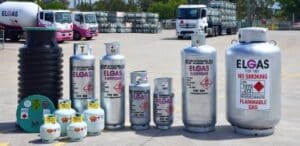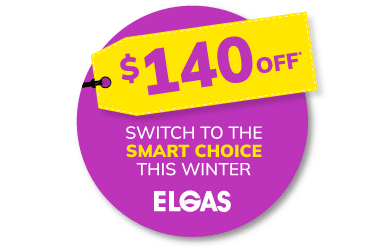LPG FAQ • Frequently Asked Questions
Have BBQ gas questions? See our SWAP’n’GO BBQ GAS FAQs
Also see our Glossary for LPG & Gas Appliances
About LPG Gas
What is LPG Gas?
There is a lot more to LPG gas than you might think.
Please see What is LPG?
What are the physical properties of LPG?
Properties of LPG including specific gravity, boiling point, vapour expansion, energy content, combustion facts, flame temperature, flash point & more…
Please see LPG Gas Physical Properties
Where does LPG come from & how is it made?
Learn about the sources and the production process for LPG.
Please see Where LPG Comes From & How is it Made
What are the LPG conversion values: KG, Litres, MJ, kWh & M³?
Unlike water, 1kg of LPG does NOT equal 1L of LPG. Use the handy conversion table that includes all common gas bottle sizes.
Please see LPG Conversion Value Chart for KG, Litres, MJ, kWh & M³
What is the difference between LPG and natural gas?
LPG and natural gas are similar but not interchangeable. LPG is propane and natural gas is methane but there are many more differences…
Please see Comparison: LPG & Natural Gas, Propane, Butane, Methane, LNG & CNG
What is LPG used for?
The uses for LPG are in the hundreds, if not thousands. The most common is as a fuel gas for cooking, heating and hot water but you should have a look at some of the more exotic uses…
Please see Uses of LPG
Why is a gas flame blue and why is it important?
The lack of a blue flame, replaced by a red or yellow flame, is the sign of a possible carbon monoxide problem and an indication that your appliance needs immediate servicing. Learn all the details…
Please see The Importance of a Blue Flame
What is the difference between LPG and Propane?
The short answer is “Not much”. LPG can be propane, butane or a mixture of the two. Find out the full story for you country…
Please see Propane & LPG – What’s
What is the difference between liquid and vapour LPG?
Did you know that the LPG in your gas bottle is both liquid and gas at the same time? And it boils to change from liquid to gas!
Please see Liquid vs Vapour LPG – Learn the Difference
What is a Megajoule – MJ?
A megajoule and a kilowatt are very different things. One is used to measure gas consumption and one is used to measure heat output. Find out the whole story…
Please see A Megajoule or Mj Probably Isn’t What You Think
Is LPG used to fuel motor vehicles?
If you’ve ever been to a petrol station, you already know the answer to this. Many petrol stations sell Autogas, which is another name for LPG, when used as a vehicular fuel…
Yes, but it is different, as the Propane may be blended with Butane. This is commonly known as Autogas.
New to LPG Gas Questions
How do I operate a home LPG gas system?
Confused by all the valves and fittings? Learn all about gas changeover valves, regulators and even pigtails!
Please see information you need to know if you are a New User of Home LPG
How do I know which LPG gas supplier to choose?
Choose us because we’re nice people! But if that isn’t enough, learn how to compare LPG suppliers and what to look for before you decide…
Please see How to Compare LPG Gas Suppliers
How do I add LPG to my all-electric home and how much does it cost?
To add LPG to your home, you engage a licensed gas fitter to install the gas regulator, changeover valve and the “pigtails”.
The gas fitter also connects the gas line from the regulator to your appliance(s).
These components and the appliances are your property.
Please see How To Add LPG Gas to Your Home for more details
The cost of the installation includes regulator, valve, pigtails, the gas line to the appliances and the cost of the gas fitter’s labour.
The cost will vary by the length of the gas line required between the regulator and the appliances and the individual gas fitter.
The cost is typically in the $550 to $900 range.
You do not need to buy the gas bottles. ELGAS owns and provides the gas bottles.
How reliable is ELGAS LPG?
ELGAS prides itself on its Surety of Supply.
ELGAS has flexible access to many LPG sources, including imports, to help maintain supply security.
Our main supply terminals include a dedicated facility at Dandenong, in Victoria, and an LPG storage cavern at Port Botany in Sydney.
We also have Australia’s largest fleet of LPG delivery vehicles to ensure a continuous flow of LPG to and through the ELGAS supply network.
Where is ELGAS LPG available?
We supply LPG to most parts of Australia through strategically located depots and Customer Service Centres that provide localised service.
Gas Bottle & Regulator Questions
What gas bottles sizes do I need for my home?
Most popular gas bottle size for homes is the installation of two 45kg gas bottles. That way you always have a backup bottle when one runs out, just make sure to order when the first one goes empty.
Please see LPG Gas Bottle-Cylinder Sizing for Homes
Are there restrictions on where gas bottles can be located?
Yes. There are gas exclusion zones based on wall openings, drains and ignitions sources to determine how far or how close a gas bottle-cylinder can be.
Ignition sources include air conditioners and other electrical items as well as your BBQ and patio heater.
Please see LPG Gas Bottle-Cylinder Placement Guide with helpful diagrams
What does a gas regulator do and what about all the gas fittings?
A gas regulator reduces the pressure of the gas going from the LPG gas bottles to your home and appliances. The fittings connect it all together but you really need to learn about gas changeover valves and gas bottle valves…
Please see Home LPG Gas Regulators and Fittings
What are LCC27 & POL Valves and Cylinders?
LCC27 gas bottles were introduced into Australia in 2021 to replace the older POL valves on BBQ size gas bottles. LCC27 gas bottles are safer, as gas will not come out if a gas regulator isn’t properly attached.
Please see LCC 27 & POL Valves & Cylinders Explained
Why does ice form on gas bottles and regulators?
Because they get cold! The real question is why do they get so cold and to understand that, you’ll have to read…
Please see Ice and Condensation on Gas Bottles & Regulators
Ordering Questions
Are there any special offers for new customers?
Yes, please see our New Customer Offer
Get $140 in LPG Account Credits!
Choice of 2-Year Fixed or Variable 45kg Gas Bottle Price
No Lock-in Contracts
We return your old gas bottles for you
It is a great time to switch to ELGAS
Managing LPG Gas Supply Questions
How is my home LPG gas delivered?
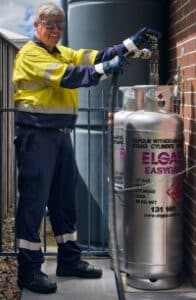 ELGAS has two methods of delivering LPG gas to your home:
ELGAS has two methods of delivering LPG gas to your home:
Automatic Tanker Delivery: Exclusive to ELGAS , EasyGas® involves delivery via state of the art tankers, which refill your LPG gas bottles on site.
You won’t have to remember to order LPG gas bottles and there’s no more replacement of cylinders.
Elgas monitors your usage and schedules regular LPG gas tanker deliveries to suit your needs.
It truly is EFFORTLESS LPG™
LPG Gas Bottle Exchange Program: In cases where we are unable to deliver via tanker, we deliver LPG gas bottles to your home.
With two LPG gas bottles connected, you just switch from the empty to the full bottle when the first bottle runs out, so you never run out of gas. Just remember to order another bottle as soon as the first bottle goes empty.
How do I check how much LPG gas is left in my gas bottle?
A bucket of hot water and the palm of your hand are all you need. Learn how to do the hot water test to find out the level of your LPG gas bottles.
For detailed instructions see How Much Gas is Left in the Gas Bottle
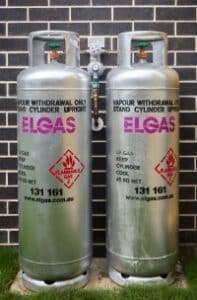 Why do I need two LPG gas bottles?
Why do I need two LPG gas bottles?
So you don’t end up taking cold showers? Seriously, with two LPG gas bottles, when the first one runs out you just switch to the second one. That’s also the time to order a fresh gas bottle.
Please see 2 Gas Bottles are Better than 1
How long should a 45kg gas bottle last?
The proverbial “How long is a piece of string”. It all depends on the number and sizes of the gas appliances being used. More and bigger appliances means faster use. Some simple arithmetic will get you the answer…
For a reference chart with examples for various appliances and for multiple appliance homes:
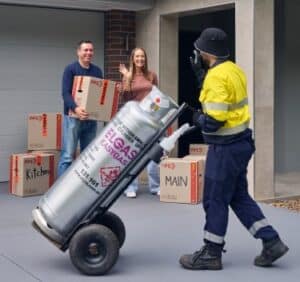 What should we do if we are moving?
What should we do if we are moving?
Just give us a call on 131 161. We can handle the gas bottles in the home you are leaving and get you full ones delivered to your new home.
Please see Moving Home with LPG Gas when you are ready to move
Safety Questions
Is LPG gas dangerous?
If used and handled in accordance with prescribed procedures LPG gas is safe.
As with electricity, natural gas, petroleum and other household chemicals, care should always be taken when using LPG gas.
ELGAS has established an unrivalled reputation for safety, from regular compliance checks of your LPG gas bottles to the comprehensive safety and maintenance schedule of our LPG gas tankers.
Our LPG Gas & Safety page provides detailed information.
Why does LPG gas have an odour?
An odorant is added to LPG gas as a safety measure, so you can tell if you have any leaks. Otherwise, LPG gas is naturally odour free.
Please see The Smell of Safety – Odourised Gas
Why do LPG gas bottles have to remain upright?
LPG gas bottles must be used and stored upright for safety reasons.
All home and BBQ gas bottles are fitted with pressure relief valves, which are designed to safely release gas in the event that the gas bottle becomes hot and the pressure becomes too great.
The pressure relief valves are incorporated into the main valve, which is at the top of the bottle.
Inside the bottle, the LPG exists as liquid at the bottom and gas vapour at the top. Keeping the LPG gas bottles upright ensures that the built in safety valve works properly.
Can an LPG gas bottle be used inside a home?
You should always avoid taking gas bottles into a home or any enclosed structure. LPG gas bottles should be stored outdoors, in a well ventilated location.
Please see Indoor Storage of LPG Gas Bottles
Are LPG gas heaters safe?
Yes, when used according to the manufacturer’s instructions. Just don’t take an outdoor gas heater indoors, as they aren’t designed for indoor use and can create a carbon monoxide safety hazard.
Also, please see 25 LPG Gas Heater Safety Tips
What are the special LPG gas heater requirements in Victoria?
The requirements deal primarily with emissions. The good news is that most modern gas heaters are Victoria compliant. If you buy it in Victoria, the appliance dealer should be well versed in this requirement, as it has been in force for many years.
Please see Victoria Gas Heater Regulations explained
What do we do with our LPG gas bottles in the event of a bushfire?
For home gas bottles, turn them off, leave them upright where they are and clear away any brush or other flammable material. For full instructions, including what to do with BBQ gas bottles, please read the following:
Please see LPG Gas Bottles Bushfire Safety
Where do I find an SDS for LPG gas?
You can download it right here: LPG Safety Data Sheet
Price Questions
Why does the price of LPG gas vary from time to time?
The price of LPG gas varies on a monthly basis based on a range of international and local market factors. It does get a bit complicated, so please read the post: Australian LPG Pricing Explained
Why is the price of Autogas lower than the price of LPG gas for my home?
Autogas is typically a different type of gas, with a percentage mix of Butane. But the pricing is mainly based on the volume used.
Service stations purchase their LPG in large volumes, storing up to 65,000 litres at a time and refilling frequently.
The cost of delivery is also VERY different.
With Autogas, we can deliver an entire tanker full of gas within a couple of hours.
With home delivery, that same amount of gas could take many days to deliver.
Also, remember that with Autogas, you go to the gas and you provide the labour to fill your tank instead of having the gas brought to your home and having someone else do the filling.
Payment Options
Does ELGAS offer online transactions for LPG gas?
You can access our Online Services that allows you to source your up-to-date account information, order LPG gas and make online payments, check delivery dates, leave special delivery instructions and more.
No special password required for residential customers. Just enter your customer number and surname and you are ready to go!
What options do I have for paying my ELGAS LPG gas invoices?
Convenient LPG gas payment options include Direct Debit, online credit card, BPAY, Pay-By-Phone or Pay-By-Mail.
Appliance Questions
What do LPG gas appliance Star Ratings really mean & how do you use them?
They are an indicator of the energy efficiency of your LPG gas appliances. The higher the star rating, the more energy efficient the appliance.
Please see Star Ratings for Gas Hot Water Heater Systems or
Star Ratings for Gas Heaters, Gas Wall Furnaces & Gas Fireplaces
How do I connect & disconnect LPG gas bayonet fittings?
It’s a lot like installing a bayonet light globe. Push in and turn clockwise to attach a gas bayonet. Push in again and turn anti-clockwise to remove the gas bayonet.
Please see Connecting & Disconnecting Gas Bayonet Fittings
What are the different kinds of LPG gas heaters?
Flued gas heaters and portable (unflued) gas heaters are the two main types. Within those broad categories are a number of sub-types. There’s a bit to it, so have a read…
Please see Gas Heater Reviews by Type & Price
What are the different kinds of LPG gas fireplaces?
Based in the method of installation, the broad categories are freestanding gas fireplaces, inbuilt gas fireplaces and gas fireplace inserts, that fit into an existing brick fireplace. There are sub-categories of gas fireplaces that are explained in the following:
Please see Gas Fireplace Reviews by Type & Price
What is the difference between LPG gas flued & portable heaters?
The flue. Flued gas heaters have a fixed installation spot and use a flue pipe to route the combustion gases out of your home. Portable or unflued gas heaters are designed to not need a flue by minimising the indoor emissions. They are portable, using a gas hose and bayonet connection to hook it up.
Please see Comparing Flued and Unflued Gas Heaters
What is the difference between LPG Gas Tankless Continuous Flow Hot Water and Traditional LPG Gas Hot Water Tanks?
Tankless, continuous flow or instant are all just different names for the same unit. As described, a tankless hot water heater does not have a tank. It uses a heat exchanger to heat the water as you use it. Traditional hot water heaters have the big storage cylinder that we are all familiar with.
Please see Tankless Continuous Flow Hot Water vs Traditional Hot Water Tanks
What size LPG gas heater do I need?
Another “how long is a piece of string” question. It depends on the size of the area you want to heat, the climate where you live and the insulation in your home, amongst a few other things. It’s not as complicated as it sounds, just have a read…
Please see Gas Heater Sizing Facts
What size LPG gas hot water system do I need?
If you buy a tankless hot water heater, it only depends on how many showers people take SIMULTANEOUSLY. If you buy a storage tank hot water heater, it depends on the number of people taking showers and how long they stay in. The use of water saving showerheads is also a factor. It’s actually pretty easy to figure out, once someone explains it…
Please see Gas Hot Water System Sizing Facts
How Does an LPG Gas Tankless Water Heater Work?
It has a heat exchanger that heats the water as you use it, so you never run out of hot water.
Please see Tankless Water Heaters Explained

